
Volume
26, No. 12 – December 2013
Volume 26, No. 12
Editor: Stephen L. Seftenberg
Website:
www.CivilWarRoundTablePalmBeach.org
President's Message
Our fun-filled Annual Holiday Party will be on Wednesday, December
11th at 7:00 PM. I hope to see all members attend. Please feel free to
bring a guest. The Round Table will supply a meat and cheese platter.
However, all members are asked to bring an appetizer, salad, entrée,
casserole, or dessert. Please be sure to bring your raffle
contributions. They do not have to be Civil War related. Small gift
certificates are always appreciated. A big "thank you" to Harold Teltser
for his generous donation of a $25.00 Publix gift card. Make sure you
buy your raffle tickets and here’s hoping you hold a winning ticket. Of
course, please be sure to bring a check for your 2014 membership if you
have not already done so. Finally, everyone should help to clean up and
return the room the room to its pristine condition. If everyone pitches
in, this will only take a few minutes.
Gerridine LaRovere, President
December 11, 2013 Program
Robert N. Macomber is an award-winning and internationally recognized
author, lecturer, and TV commentator. His Honor Series of naval
thrillers cover the career of a fictional American naval officer, Peter
Wake, which starts in 1863, during the Civil War. From 1882 to the end
of his career in 1908, Wake serves in America’s first espionage agency,
the Office of Naval Intelligence. Mr. Macomber’s novels illuminate the
U.S. Navy’s critical role in the expansion of America from a continental
country into a global power. The Honor Series has readers across North
America and Europe, and has garnered acclaim from critics, authors, and
readers. The tenth book in the series, Honorable Lies, set in
1888 Havana, came out in October 2012 to rave reviews and was an
amazon.com best-seller. The newest novel, Honors Rendered, set
in the South Pacific in 1889, came out in September 2013, with a 40
event book tour from Maine to Key West. Eleven of the 22 novels planned
for the Honor Series published to date are: At the Edge of Honor
(2003 Patrick D. Smith Literary Award for Best Historical Novel of
Florida), Point of Honor (2004 John Esten Cooke Literary Award
for Best Work in Southern Fiction), Honorable Mention, A Dishonorable
Few, An Affair of Honor, A Different Kind of Honor (American Library
Association’s 2008 W. Y. Boyd Literary Award for Excellence in Military
Fiction--The highest national award and monetary prize in the genre),
The Honored Dead, The Darkest Shade of Honor, Honor
Bound, Honorable Lies, & Honors Rendered (published in
September 2013). As well as the aforementioned awards, Macomber is the
recipient of the 2001 Florida Genealogical Society’s Outstanding
Achievement Award for his non-fiction magazine and newspaper work on
Florida’s maritime history, was selected as Florida Monthly Magazine’s
Most Intriguing Author of 2006, and named Grand Marshal of Florida’s
2013 Edison Pageant of Light Parade.
Mr. Macomber annually lectures around the world as guest author
aboard ships such as Queen Mary 2, Queen Victoria, Queen Elizabeth,
the Silver Sea Line, and the Seabourn Line. He has been a naval history
lecturer for the American History Forum and the Civil War Education
Association, and has spoken at historical and academic venues around the
United States. His lectures span 43 maritime and literary topics. He has
appeared in many Florida PBS maritime history documentaries, and has
been a featured author at state, regional, and international book
festivals. In addition to his other work, Macomber is a defense
consultant, an annual lecturer in the Distinguished Military Author
Series at the Center for Army Analysis at Fort Belvoir, Washington D.C.,
and has been a Distinguished Lecturer at the U.S. Southern Command, the
U.S. European Command in Germany, and for the Supreme Allied Commander
Europe at NATO Headquarters in Belgium. He has also lectured at the
Office of Naval Intelligence, the West Point Society, the Military
Officers Association of the United States, the National Geospatial
Intelligence Agency and various other government and military
organizations.
As attendees at his previous 9 talks to the Roundtable, whatever
Macomber chooses to discuss will enthrall, enlighten and entertain us.
Don’t miss this annual event!
November 13, 2013 Program
“The USS Monitor, Then and Now”
Dr. Francis J. DuCoin, a consultant at the U.S.S. Monitor Center at
the Mariners' Museum in Newport News, Virginia, led us through the
thrilling raising and salvaging of USS Monitor. Dr. DuCoin
first gave us the background of the famous battle between USS
Monitor and CSS Virginia (originally U.S.S. Merrimack).
The French (1859) and the English (1860) had already launched “all iron”
ships. In addition, explosive shells developed and used by Russia in the
Crimean War meant wooden hulls were doomed. At the beginning of the war,
the Northern navy had bungled the destruction of USS Merrimack,
which sank at anchor in Norfolk, Virginia. Its boilers and engines had
been saved. Stephen Mallory, the Confederate Secretary of the Navy,
realized that the South could never build a wooden-hulled navy to
compete with t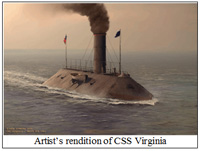 he
Northern wooden-hulled navy. Instead, he recommended to President
Jefferson Davis that the South refloat and retrofit USS Merrimack
as a “casemate” ironclad. [A "casemate ironclad" carries all of its guns
on the top of the ship but fires through fixed gunports. It is an
"intermediate" step between traditional broadside frigate and modern
warships with moveable turrets.] Conversion began May 30, 1861 and was
completed on March 8, 1862 (282 days). The converted vessel was
christened CSS Virginia. he
Northern wooden-hulled navy. Instead, he recommended to President
Jefferson Davis that the South refloat and retrofit USS Merrimack
as a “casemate” ironclad. [A "casemate ironclad" carries all of its guns
on the top of the ship but fires through fixed gunports. It is an
"intermediate" step between traditional broadside frigate and modern
warships with moveable turrets.] Conversion began May 30, 1861 and was
completed on March 8, 1862 (282 days). The converted vessel was
christened CSS Virginia.
The Northern Secretary of the Navy, Gideon Welles, knew what the
South was doing and was desperate to match the threat. Welles had three
options and appointed a three-man commission to help him decide:
(1) USS New Ironsides, which used both sail and engines.
This would be the most heavily armed vessel in the world but would take
another year to launch.
(2) USS Galena, which had a rubber lining under the iron
cladding. Cornelius S. Bushnell, a New England ship builder and its
designer, was a friend of Welles and a good lobbyist who got a bill
through Congress to finance its construction. It participated in the
Battle of Malvern Hill, where the many shot holes in its hull exposed
its defective design.
(3) USS Monitor, the brain child of John Ericsson (July 31,
1803 - March 8, 1889), who was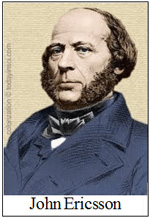 already at odds with the U.S. Navy because in 1844 a cannon he had not
designed on USS Princeton, which he had designed, blew up,
killing both President Tyler’s Secretary of State and Secretary of the
Navy. Ericsson was not at fault, but was ostracized by U.S. officials.
The commissioners, when shown Ericsson’s plans, scoffed that the “cheese
box on a raft” was unstable. Ericsson proved them wrong. Monitor
took only 118 days from conception to launch! Ericsson’s secret was to
subcontract the construction, to use mostly items “off the shelf” and to
use a sort of “PERT” chart. All but 18 inches of Monitor was
under water – the kitchen, sleeping quarters, engine room, etc. Ericsson
even had to invent a toilet that would work under water! The revolving
turret was the first ever built. Over 80 different patents were
involved.
already at odds with the U.S. Navy because in 1844 a cannon he had not
designed on USS Princeton, which he had designed, blew up,
killing both President Tyler’s Secretary of State and Secretary of the
Navy. Ericsson was not at fault, but was ostracized by U.S. officials.
The commissioners, when shown Ericsson’s plans, scoffed that the “cheese
box on a raft” was unstable. Ericsson proved them wrong. Monitor
took only 118 days from conception to launch! Ericsson’s secret was to
subcontract the construction, to use mostly items “off the shelf” and to
use a sort of “PERT” chart. All but 18 inches of Monitor was
under water – the kitchen, sleeping quarters, engine room, etc. Ericsson
even had to invent a toilet that would work under water! The revolving
turret was the first ever built. Over 80 different patents were
involved.
 On
March 8, 1862, Virginia, commanded by Flag Officer Franklin
Buchanan, CSN, slowly chugged into Hampton Roads on what was nominally a
trial run. Buchanan may not have planned to attack, but an article in
the New York Times about the launching of Monitor accelerated his
plans. On the surface, his ship was badly outgunned (10 guns to over 100
guns on the four wooden-hulled U.S. ships attempting to blockade
Norfolk). The first day of the battle was the worst defeat for the U.S.
Navy until Pearl Harbor. After sinking two Northern vessels, CSS
Virginia retired slowly to Norfolk. That evening Monitor
showed up. A "famous" painting of the battle hung in the U.S. Capitol
for 25 years. No one liked it and it was taken down. The painting is now
in storage at the U.S. Naval Academy. The only problem with the painting
(other than its excessive size–6 x 12 feet--and poor artistry) is that
hardly anyone on either side (and certainly not the 10,000 would-be
spectators on shore shown in the painting) saw the battle! Clouds of
smoke from the soft coal burned by Virginia and from the clouds
of powder from each shot shrouded the scene. The second day of the
battle was a technical On
March 8, 1862, Virginia, commanded by Flag Officer Franklin
Buchanan, CSN, slowly chugged into Hampton Roads on what was nominally a
trial run. Buchanan may not have planned to attack, but an article in
the New York Times about the launching of Monitor accelerated his
plans. On the surface, his ship was badly outgunned (10 guns to over 100
guns on the four wooden-hulled U.S. ships attempting to blockade
Norfolk). The first day of the battle was the worst defeat for the U.S.
Navy until Pearl Harbor. After sinking two Northern vessels, CSS
Virginia retired slowly to Norfolk. That evening Monitor
showed up. A "famous" painting of the battle hung in the U.S. Capitol
for 25 years. No one liked it and it was taken down. The painting is now
in storage at the U.S. Naval Academy. The only problem with the painting
(other than its excessive size–6 x 12 feet--and poor artistry) is that
hardly anyone on either side (and certainly not the 10,000 would-be
spectators on shore shown in the painting) saw the battle! Clouds of
smoke from the soft coal burned by Virginia and from the clouds
of powder from each shot shrouded the scene. The second day of the
battle was a technical
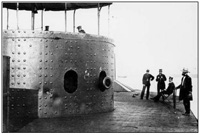 "draw"
with both sides claiming victory. What is clear, however, is that
Virginia failed to break the Union blockade. Some students of the
Civil War believe that if Virginia had broken the blockade,
England would have at least recognized the Confederacy as a "nation" or
might have even entered the war on the side of the Confederacy, and that
likely would have meant a Confederate victory. We may have came within
one day of being two countries. "draw"
with both sides claiming victory. What is clear, however, is that
Virginia failed to break the Union blockade. Some students of the
Civil War believe that if Virginia had broken the blockade,
England would have at least recognized the Confederacy as a "nation" or
might have even entered the war on the side of the Confederacy, and that
likely would have meant a Confederate victory. We may have came within
one day of being two countries.
The solid shots may have dented their hulls, but the vessels suffered
little or no damage. The picture at the left shows de nts
on the Monitor’s turret, some from the Virginia and some from
Confederate shore batteries at Malvern Hill. Lt. John Lorimar Worden, U.
S. N., the Commanding Officer, was the only casualty when a stray shell
fragment penetrated the view port through which he was peering.
Monitor fired 40 times (used 41 shells because they double loaded
one time). Virginia retired to Norfolk and eventually was
scuttled when the Union army captured Norfolk. After several months
supporting McClellan’s Peninsular Campaign, Monitor sank on
December 30, 1862, with 16 sailors aboard). nts
on the Monitor’s turret, some from the Virginia and some from
Confederate shore batteries at Malvern Hill. Lt. John Lorimar Worden, U.
S. N., the Commanding Officer, was the only casualty when a stray shell
fragment penetrated the view port through which he was peering.
Monitor fired 40 times (used 41 shells because they double loaded
one time). Virginia retired to Norfolk and eventually was
scuttled when the Union army captured Norfolk. After several months
supporting McClellan’s Peninsular Campaign, Monitor sank on
December 30, 1862, with 16 sailors aboard).
 DuCoin
now turned to the search for the wreck of Monitor. In 1953, the
US Navy abandoned the wreck. In 1973, scientists aboard Duke
University’s research vessel Eastward located Monitor,
under 220 feet of water approximately 16 miles South-Southeast of Cape
Hatteras Lighthouse. The discovery of Monitor was announced
jointly by Duke University and the North Carolina Department of Archives
and History on March 7, 1974. On January 30, 1975, the Secretary of
Commerce designated the remains of Monitor and a column of
water one nautical mile in diameter surrounding the vessel as the first
U.S. National Marine Sanctuary. U.S. Navy interest in raising the entire
ship ended in 1978 when it estimated that salvaging the entire wreck
might cost in excess of $70 million. Nevertheless, research continued
and DuCoin
now turned to the search for the wreck of Monitor. In 1953, the
US Navy abandoned the wreck. In 1973, scientists aboard Duke
University’s research vessel Eastward located Monitor,
under 220 feet of water approximately 16 miles South-Southeast of Cape
Hatteras Lighthouse. The discovery of Monitor was announced
jointly by Duke University and the North Carolina Department of Archives
and History on March 7, 1974. On January 30, 1975, the Secretary of
Commerce designated the remains of Monitor and a column of
water one nautical mile in diameter surrounding the vessel as the first
U.S. National Marine Sanctuary. U.S. Navy interest in raising the entire
ship ended in 1978 when it estimated that salvaging the entire wreck
might cost in excess of $70 million. Nevertheless, research continued
and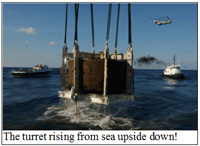 artifacts continued to be recovered, including the ship's 1,500-pound
(680 kg) anchor in 1983. The growing number of relics required
conservation and a proper home so on March 9, 1987, the 125th
anniversary of the battle, Interior Secretary Donald Hodel, designated
Monitor a National Historic Landmark and the U.S. National
Oceanic and Atmospheric Administration (NOAA), in charge of all U.S.
marine sanctuaries, selected the Mariners' Museum as the custodian of
all Monitor artifacts.
artifacts continued to be recovered, including the ship's 1,500-pound
(680 kg) anchor in 1983. The growing number of relics required
conservation and a proper home so on March 9, 1987, the 125th
anniversary of the battle, Interior Secretary Donald Hodel, designated
Monitor a National Historic Landmark and the U.S. National
Oceanic and Atmospheric Administration (NOAA), in charge of all U.S.
marine sanctuaries, selected the Mariners' Museum as the custodian of
all Monitor artifacts.
 Divers
recovered an anchor, a propeller, a compass, an engine and a ship’s
clock (stopped at 1:05 AM!). The turret had come off and was upside
down, half buried in sand. It was not recovered until 2002 along with
part of the hull on top of it. The divers also discovered two skeletons
in the turret, triggering the military protocol for such an event. Ever
since, military forensic scientists have been trying to identify the
Union sailors and find living relatives. Reconstructing the skulls,
which prior to this took a lot of time and expert forensics, was
accomplished in three weeks at a total cost of $48.50 by a dentist
friend of Dr. DuCoin! The remains of the two sailors were buried with
full military honors Friday, March 8, 2013 at Arlington National
Cemetery in Virginia, 151 years to the day after the battle began! Divers
recovered an anchor, a propeller, a compass, an engine and a ship’s
clock (stopped at 1:05 AM!). The turret had come off and was upside
down, half buried in sand. It was not recovered until 2002 along with
part of the hull on top of it. The divers also discovered two skeletons
in the turret, triggering the military protocol for such an event. Ever
since, military forensic scientists have been trying to identify the
Union sailors and find living relatives. Reconstructing the skulls,
which prior to this took a lot of time and expert forensics, was
accomplished in three weeks at a total cost of $48.50 by a dentist
friend of Dr. DuCoin! The remains of the two sailors were buried with
full military honors Friday, March 8, 2013 at Arlington National
Cemetery in Virginia, 151 years to the day after the battle began!
Dr. DuCoin then turned to the work being done in the Mariner’s Museum
to preserve the many artifacts recovered from the seabed. In the 1990's,
NOAA decided that it could afford to recover and display only the most
significant artifacts. To date some 210 tons of artifacts have been
recovered. of which the most important are: the turret (upside down),
the engine (also upside down) and the Dahlgren guns and gun carriages.
guns and gun carriages.
The revolving gun turret is the most famous feature of USS
Monitor. While the ship's designer, John Ericsson, was not the
first to envision a revolving turret, his design for Monitor
was the first completed turreted naval vessel to be built. The turret is
21 1/2 feet in diameter and nine feet tall. It was constructed of eight
one-inch-thick iron plates that, with the exception of the first two
layers, were bolted together so that they could be easily replaced if
needed. It weighed about 120 tons and was able to rotate with the help
of two steam engines that used a crank to turn four gears.
E ricsson’s
naval steam engine was also a pioneering project. Naval steam engines of
the day were massive machines that sometimes were several stories tall.
The pistons that drove the propeller shafts of these monsters usually
moved up and down, adding to the engines’ size. Ericsson’s pistons moved
horizontally, which greatly reduced the height of the engine. He also
reduced its width by devising pistons that didn’t have to travel as far
to produce the power needed to drive the ship. The result was a
relatively compact engine that was entirely below Monitor’s
waterline and thus well-protected from enemy gunfire. ricsson’s
naval steam engine was also a pioneering project. Naval steam engines of
the day were massive machines that sometimes were several stories tall.
The pistons that drove the propeller shafts of these monsters usually
moved up and down, adding to the engines’ size. Ericsson’s pistons moved
horizontally, which greatly reduced the height of the engine. He also
reduced its width by devising pistons that didn’t have to travel as far
to produce the power needed to drive the ship. The result was a
relatively compact engine that was entirely below Monitor’s
waterline and thus well-protected from enemy gunfire.
Monitor had two XI-inch Dahlgren, smooth-bore cannons that
weighed nearly nine tons each.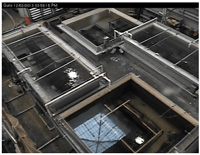 Although most warships had many more cannons, Monitor's
rotating gun turret made it possible for only two cannons to be capable
of firing in almost any direction without turning the ship. These
cannons fired solid shots weighing 140 pounds with 15 pounds of
gunpowder. After the battle one cannon was engraved "Worden Monitor &
Merrimac" (in honor of Monitor's commander), and the other was
engraved "Ericsson Monitor & Merrimac" (in honor of the ship's
designer). After the turret was raised in 2002, conservators began the
long process of excavating the fragile cannons from the
Although most warships had many more cannons, Monitor's
rotating gun turret made it possible for only two cannons to be capable
of firing in almost any direction without turning the ship. These
cannons fired solid shots weighing 140 pounds with 15 pounds of
gunpowder. After the battle one cannon was engraved "Worden Monitor &
Merrimac" (in honor of Monitor's commander), and the other was
engraved "Ericsson Monitor & Merrimac" (in honor of the ship's
designer). After the turret was raised in 2002, conservators began the
long process of excavating the fragile cannons from the
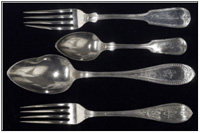 turret
and stabilizing them. The cannons were removed from the turret in 2004
and placed in conservation tanks They are currently undergoing extended
electrolytic soaking (see picture at left) to remove chlorides from the
iron. This process will take approximately five years, after which the
cannons will be on display in the museum. turret
and stabilizing them. The cannons were removed from the turret in 2004
and placed in conservation tanks They are currently undergoing extended
electrolytic soaking (see picture at left) to remove chlorides from the
iron. This process will take approximately five years, after which the
cannons will be on display in the museum.
The restoration of the corroded iron of the turret is a 15-to-18 year
project. However, not all the artifacts require extensive treatment:
when Monitor's turret was excavated in 2002, 24 pieces of
silver tableware were discovered. Of these recovered artifacts, the
handles of five pieces were engraved with either the names or initials
of crew members and officers. Other artifacts recovered included a
butter dish, which was stolen from Monitor when it was opened to
the public after the battle. Apparently the thief’s family felt guilty
about this because it was donated back to the Navy in 1880!
Dr. DuCoin’s talk was so well-received that several audience member
want him invited back when restoration is further along.
Last changed: 12/04/13
Home
About News
Newsletters
Calendar
Memories
Links Join
|

